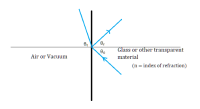
College Physics
11th Edition
ISBN: 9781305952300
Author: Raymond A. Serway, Chris Vuille
Publisher: Cengage Learning
expand_more
expand_more
format_list_bulleted
Question
n = 1.7 and (A beam of light) θ₀ = 17°. Calculate θᵣ, the reflected angle.

Expert Solution
This question has been solved!
Explore an expertly crafted, step-by-step solution for a thorough understanding of key concepts.
This is a popular solution
Trending nowThis is a popular solution!
Step by stepSolved in 2 steps with 2 images

Knowledge Booster
Learn more about
Need a deep-dive on the concept behind this application? Look no further. Learn more about this topic, physics and related others by exploring similar questions and additional content below.Similar questions
- Find the angle between the following 3D vectors: 8.46 3.11 7.25' 9.36 15.5 1.24' Angle Between Two Vectors and — 1.35 9.91 12.6 1.35' 10.2" 3.20arrow_forwardQUESTION 28 (round to the nearest hundreth)arrow_forwardThe speed of light in a particular type of glass is 1.40 108 m/s. What is the index of refraction of the glass?arrow_forward
- The speed of light in a particular type of glass is 1.68 108 m/s. What is the index of refraction of the glass?arrow_forwardA ray of light enters a narrow prism along the normal as shown. Calculate the angle (degrees) at which the ray exits the prism, relative to North (i.e. up the page, not the normal to the glass). The index of refraction of the prism is n = 1.54. The angle of the prism is theta = 19.42 deg.arrow_forwardCould I have help with this physics problemarrow_forward
- Water has an index of refraction of 1.33. What is the speed of light and water in km/s?arrow_forwardDistances in space are often quoted in units of light years, the distance light travels in one year (365.25 days). How many meters is a light year? Provide the solution: x 1015 marrow_forwardWhat would be the speed of light through a particular medium if the frequency is 5.63 x 106 Hz and the wavelength is 63.86 m? Your answer for this problem will not have any decimal places.arrow_forward
- Consider a mirror lying along the x-axis in R2. A laser starts at the point (−2, 6) and is fired in the direction of ⟨4, −3⟩. The beam travels until it hits the mirror, where it reflects off the mirror and then travels until it hits a wall on the line x = 20. (a) Give a parametrization for the initial path of the laser. (b) At what point does this beam hit the mirror? (c) Give a parametrization for the path of the reflected beam. (d) At what point does this beam hit the wall?arrow_forwardray of light strikes a flat block of glass at an incidence angle of ?1 = 38.6°. The glass is 2.00 cm thick and has an index of refraction that equals ng = 1.52. a.)What is the angle of refraction, ?2, that describes the light ray after it enters the glass from above? (Enter your answer in degrees to at least 2 decimal places.) b.) With what angle of incidence, ?3, does the ray approach the interface at the bottom of the glass? (Enter your answer in degrees to at least 2 decimal places.) c.) With what angle of refraction, ?4, does the ray emerge from the bottom of the glass? (Enter your answer in degrees to at least 1 decimal place.) d.) The distance d separates the twice-bent ray from the path it would have taken without the glass in the way. What is this distance (in cm)? e.) At what speed (in m/s) does the light travel within the glass? f.) How many nanoseconds does the light take to pass through the glass along the angled path shown here?arrow_forward
arrow_back_ios
arrow_forward_ios
Recommended textbooks for you
 College PhysicsPhysicsISBN:9781305952300Author:Raymond A. Serway, Chris VuillePublisher:Cengage Learning
College PhysicsPhysicsISBN:9781305952300Author:Raymond A. Serway, Chris VuillePublisher:Cengage Learning University Physics (14th Edition)PhysicsISBN:9780133969290Author:Hugh D. Young, Roger A. FreedmanPublisher:PEARSON
University Physics (14th Edition)PhysicsISBN:9780133969290Author:Hugh D. Young, Roger A. FreedmanPublisher:PEARSON Introduction To Quantum MechanicsPhysicsISBN:9781107189638Author:Griffiths, David J., Schroeter, Darrell F.Publisher:Cambridge University Press
Introduction To Quantum MechanicsPhysicsISBN:9781107189638Author:Griffiths, David J., Schroeter, Darrell F.Publisher:Cambridge University Press Physics for Scientists and EngineersPhysicsISBN:9781337553278Author:Raymond A. Serway, John W. JewettPublisher:Cengage Learning
Physics for Scientists and EngineersPhysicsISBN:9781337553278Author:Raymond A. Serway, John W. JewettPublisher:Cengage Learning Lecture- Tutorials for Introductory AstronomyPhysicsISBN:9780321820464Author:Edward E. Prather, Tim P. Slater, Jeff P. Adams, Gina BrissendenPublisher:Addison-Wesley
Lecture- Tutorials for Introductory AstronomyPhysicsISBN:9780321820464Author:Edward E. Prather, Tim P. Slater, Jeff P. Adams, Gina BrissendenPublisher:Addison-Wesley College Physics: A Strategic Approach (4th Editio...PhysicsISBN:9780134609034Author:Randall D. Knight (Professor Emeritus), Brian Jones, Stuart FieldPublisher:PEARSON
College Physics: A Strategic Approach (4th Editio...PhysicsISBN:9780134609034Author:Randall D. Knight (Professor Emeritus), Brian Jones, Stuart FieldPublisher:PEARSON

College Physics
Physics
ISBN:9781305952300
Author:Raymond A. Serway, Chris Vuille
Publisher:Cengage Learning

University Physics (14th Edition)
Physics
ISBN:9780133969290
Author:Hugh D. Young, Roger A. Freedman
Publisher:PEARSON

Introduction To Quantum Mechanics
Physics
ISBN:9781107189638
Author:Griffiths, David J., Schroeter, Darrell F.
Publisher:Cambridge University Press

Physics for Scientists and Engineers
Physics
ISBN:9781337553278
Author:Raymond A. Serway, John W. Jewett
Publisher:Cengage Learning

Lecture- Tutorials for Introductory Astronomy
Physics
ISBN:9780321820464
Author:Edward E. Prather, Tim P. Slater, Jeff P. Adams, Gina Brissenden
Publisher:Addison-Wesley

College Physics: A Strategic Approach (4th Editio...
Physics
ISBN:9780134609034
Author:Randall D. Knight (Professor Emeritus), Brian Jones, Stuart Field
Publisher:PEARSON